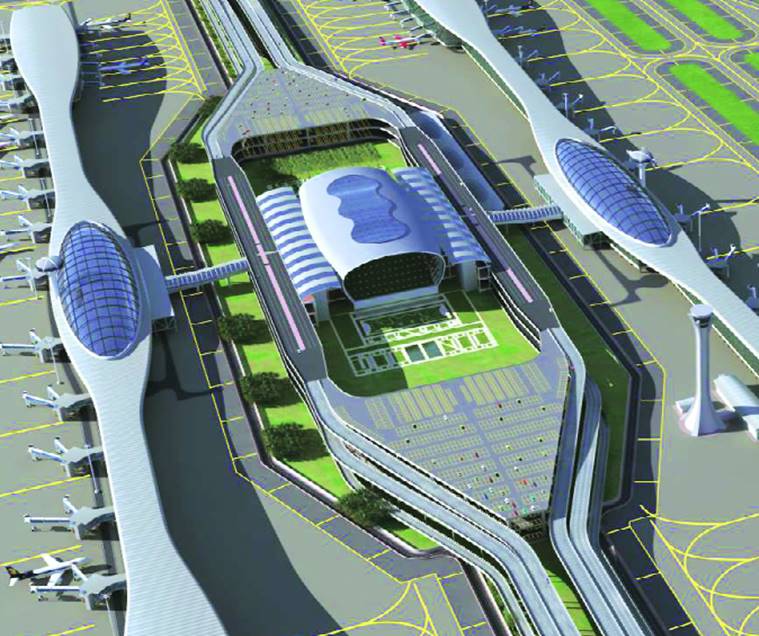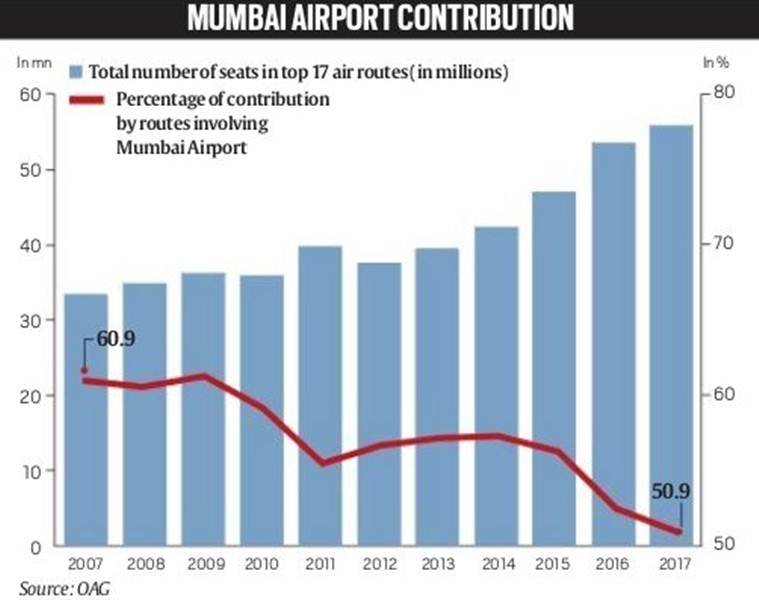Need of the hour, rising congestion: Second airport to unlock aviation growth in Mumbai
Contribution of routes that have Chhatrapati Shivaji International Airport as either origin or destination in top 17 sectors fell to 51 per cent in 2017 from 61 per cent in 2007.
 The airport, which will have two parallel runways, will eventually handle close to 80 flight movements every hour.
The airport, which will have two parallel runways, will eventually handle close to 80 flight movements every hour.
On January 20, the second-largest aerodrome in the country — Chhatrapati Shivaji International Airport (CSIA) at Mumbai — handled a record 980 flights in a single day, becoming the world’s busiest airport with a single runway. Even as few other airports in the world such as London’s Gatwick airport operate at a similar rate, the Mumbai airport is constrained for capacity and is near its saturation point in terms of handling flights as well as passengers. This has also had an impact on Mumbai’s contribution to the growth story of India’s aviation sector. A close look at data for top 17 air routes in India provided by research firm OAG shows that the percentage of seats allocated to sectors involving Mumbai came down to 51 per cent in 2017 from 61 per cent in 2007.
In terms of the pecking order, routes such as Mumbai-Chennai-Mumbai, Mumbai-Ahmedabad-Mumbai and Mumbai-Kolkata-Mumbai saw sharp fall in their positions according to number of seats over the 10-year period from 3rd to 10th, 8th to 15th and 12th to 17th, respectively. Apart from the Mumbai-Dubai-Mumbai route, none of the other routes involving the financial capital of India saw an increase in ranking.
The CSIA, which is operated by Mumbai International Airport Ltd – a joint-venture between Airports Authority of India (AAI) and a GVK-led consortium, reached 94 per cent of its maximum passenger handling capacity in 2017, according to research firm CAPA, which also said that the airport was expected to reach full capacity in 2018. Further, according to data compiled by AAI, during the nine-month period ended December 2017, Mumbai airport reported the slowest on-year growth in number of domestic aircraft movements among the top five airports of the country. While Mumbai’s domestic aircraft movements grew 2.6 per cent on year, those at Delhi, Bengaluru, Kolkata and Hyderabad grew by 11.3 per cent, 4.2 per cent, 23.1 per cent and 14 per cent, respectively.
The primary reason behind Mumbai airport nearing its full capacity is said to be the land constraints that it faces that is a key hurdle to its expansion. To address this issue, a greenfield airport is being developed at Navi Mumbai, which, once its first phase is completed by end-2019, will be able to handle up to 10 million passengers. In its second phase, expected to be complete by 2022, the airport’s capacity will increase to 25 million passengers per annum, and after the end of its third phase in 2027, it will handle 60 million passengers every year. Compared with this, the Mumbai airport’s capacity is slightly over 40 million passengers per annum.

While the CSIA only has a single runway, something that restrains growth in flight movements beyond a point, the proposed Navi Mumbai airport will have two parallel runways. During the April-December 2017 period, Mumbai airport handled 1.75 lakh domestic aircraft movements. In comparison, the Delhi airport, which has three runways, handled 2.48 lakh domestic aircraft movements during the same period. Landing and take-off of an aircraft are considered to be a separate count of movement — which means that one landing and one take-off of the same aircraft on a same flight will be considered as two movements.
Even as the financial capital of India is said to be in dire need of a second airport, the growth of country’s civil aviation sector, which has been in double digits for the last several months, is highly dependent on additional airport infrastructure, especially in major cities. While laying the foundation stone for the Navi Mumbai airport on Sunday, Prime Minister Narendra Modi had said that the need for a second airport in the Maharashtra capital was first acknowledged in 1997, when Atal Bihari Vajpayee was prime minister but no airport was developed during all these years.
“We are facing an infrastructure crisis everywhere in the world but particularly in Asia because we have to cope with a very fast growth in the number of passengers, number of aircraft in the sky. So, we must have the adaptive infrastructure in terms of air traffic control or airport to cope with that growth. But, what we are advocating for is infrastructure which has enough capacity, the good level of quality particularly technically speaking to be able to answer the requirements and the need of the airlines and of the passengers at the end of the day. And thirdly, that are affordable. As all these equipment or capacity extension take time, decision have to be made now to be implemented and effective in 5-10 years period,” International Air Transport Association’s director general and chief executive officer Alexandre de Juniac said in a statement last week.





- 01
- 02
- 03
- 04
- 05


























